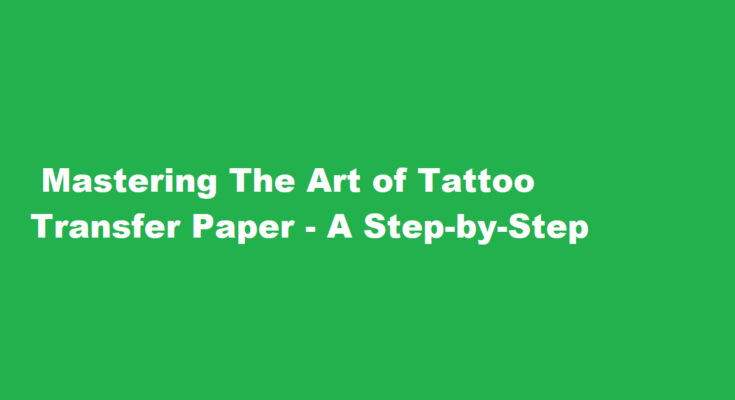Introduction
Tattoos are a form of self-expression that has been cherished for centuries. They can tell a story, commemorate an event, or simply serve as beautiful body art. However, getting the perfect tattoo requires careful planning, precise design transfer, and a skilled tattoo artist. Tattoo transfer paper plays a crucial role in the tattooing process, helping artists create accurate stencils for their clients. In this article, we will explore how to use tattoo transfer paper effectively, step by step.
Gather Your Supplies
Before you begin, it’s essential to gather all the necessary supplies. You’ll need the following
1. Tattoo Transfer Paper: You can find various types of transfer paper, such as thermal, carbon, or stencil paper. Choose the one that suits your needs.
2. Tattoo Design: Ensure you have a clear and precise design that is ready to be transferred. The design should be the exact size and placement the client desires.
3. A Photocopier or Printer: If your design is not hand-drawn, you’ll need access to a copier or printer to make a clean copy of the design.
4. Scissors: For cutting the stencil to the appropriate size.
5. Gel Deodorant: This will be used to prepare the skin for the transfer.
6. Transfer Solution: Some tattoo artists prefer to use a transfer solution, while others use green soap mixed with water as a transfer solution.
7. Skin Cleanser: To ensure the skin is clean and ready for the stencil.
Preparing the Design
Start by ensuring that your tattoo design is clean, well-defined, and the correct size. If it’s not hand-drawn, make a photocopy of the design. Avoid using inkjet prints, as they tend to smudge. A laser printer or photocopier is your best option for creating a clean, crisp copy of the design.
Preparing the Skin
Clean the area of the body where the tattoo will be placed with a skin cleanser. Ensure it’s free of oils and lotions to allow the stencil to adhere correctly. After cleaning, let the skin air dry or use a clean, disposable paper towel to pat it dry.
Applying Gel Deodorant
Gently rub a small amount of clear gel deodorant onto the skin where the tattoo will be placed. This will act as a barrier to help the stencil adhere and prevent it from smudging or fading during the tattooing process.
Cut and Position the Stencil
Cut the stencil paper to the appropriate size, leaving some extra space around the design for handling. Place the stencil paper face down on the skin. Be careful not to touch the inked side, as this can cause smudging. Position the stencil exactly where the client wants the tattoo, ensuring its level and centred.
Applying Pressure
Apply firm and even pressure to the back of the stencil paper with a clean, moistened sponge or a tattoo transfer solution. This will help transfer the ink from the stencil paper onto the skin. Make sure you cover the entire design area.
Peeling Off the Stencil
After applying pressure for a few seconds, carefully lift one corner of the stencil paper to check if the design has transferred correctly. If it hasn’t, reposition the stencil and apply more pressure. Once you’re satisfied, gently peel off the stencil paper.
Verify the Stencil
Before proceeding with the tattoo, verify that the stencil has transferred accurately and to the client’s satisfaction. Make any necessary adjustments if the positioning or size isn’t perfect.
Begin Tattooing
With the stencil in place, you’re ready to start the tattooing process. Follow your chosen tattooing technique and equipment, making sure to maintain the design’s integrity.
FREQUENTLY ASKED QUESTIONS
How do you use Vaseline transfer paper for tattoos?
After applying the stencil, I lightly dab the stencil, and rub a thin coat of vaseline over it, (doesn’t affect the stencil at all), and after running a line, I dab the ink lightly, (there should be very little of it), and it comes right up. As far as stretching the skin goes, I’d just pull it where you can.
Can you use a pen on tattoo transfer paper?
Method 1 – Freehand draw your tattoo designs on to the front side of transfer sheet (A) using a pencil or ballpoint pen. Whatever you draw will be copied exactly on to the back side of transfer sheet (A) which can then be applied on to skin.
Conclusion
Using tattoo transfer paper is a crucial step in ensuring that a tattoo design is accurately and beautifully executed on a client’s skin. By following these steps and using the right materials, you can create a clear and precise stencil, making the tattooing process smoother and more efficient. Remember that practice and attention to detail are essential for becoming a skilled tattoo artist. So, hone your skills, and enjoy the art of transforming designs into timeless body art.
Read Also : Unravelling The Secrets of Night in Little Alchemy 2



